Geochronology
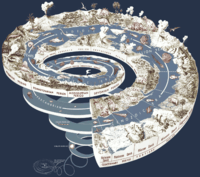
Geochronology is the science of applying dates in the past to rocks. Sometimes these rocks receive dates because they contain fossils or artifacts that can be dated.
Geologic time

On the right is a geologic clock representation. It shows some of the major units of geological time and definitive events of Earth history. The Hadean eon represents the time before fossil record of life on Earth; its upper boundary is now regarded as 4.0 Ga (billion years ago).[1] Other subdivisions reflect the evolution of life; the Archean and Proterozoic are both eons, the Palaeozoic, Mesozoic and Cenozoic are eras of the Phanerozoic eon. The two million year Quaternary period, the time of recognizable humans, is too small to be visible at this scale.
The following four timelines show the geologic time scale. The first shows the entire time from the formation of the Earth to the present, but this compresses the most recent eon. Therefore the second scale shows the most recent eon with an expanded scale. The second scale compresses the most recent era, so the most recent era is expanded in the third scale. Since the Quaternary is a very short period with short epochs, it is further expanded in the fourth scale. The second, third, and fourth timelines are therefore each subsections of their preceding timeline as indicated by asterisks. The Holocene (the latest epoch) is too small to be shown clearly on the third timeline on the right, another reason for expanding the fourth scale. The Pleistocene (P) epoch. Q stands for the Quaternary period.




Notations
Let
- ALMA represent the Asian Land Mammal Age,
- b2k represent before AD 2000,
- BP represent before present, as the chart is for 2008, this may require an added -8 for b2k,
- ELMMZ represent the European Land Mammal Mega Zone,
- FAD represent first appearance datum,
- FO represent first occurrence,
- Ga represent Gegaannum, billion years ago, or -109 b2k,
- GICC05 represent Greenland Ice Core Chronology 2005,
- GRIP represent Greenland Ice Core Project,
- GSSP represent Global Stratotype Section and Point,
- HO represent highest occurrence,
- ICS represent the International Commission on Stratigraphy,
- IUGS represent the International Union of Geological Sciences,
- LAD represent last appearance datum,
- LO represent lowest occurrence,
- Ma represent Megaannum, million years ago, or -106 b2k,
- NALMA represent the North American Land Mammal Age,
- NGRIP represent North Greenland Ice Core Project, and
- SALMA represent South American Land Mammal Age.
"The term b2 k [b2k] refers to the ice-core zero age of AD 2000; note that this is 50 years different from the zero yr for radiocarbon, which is AD 1950 [...]."[2]
Chronostratigraphy
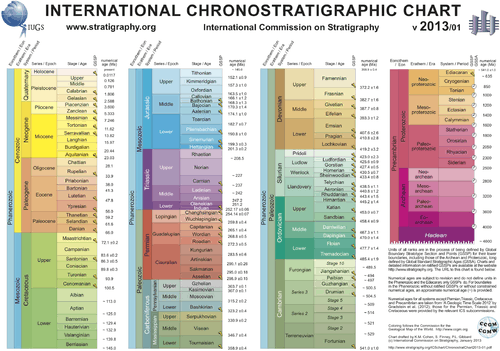
Dates have been assigned to specific geologic stratigraphy frames, columns, or columnar units.
Geochronologic time frames
| Name (English)[3] | base/start (Ma)[4] | top/end (Ma)[4] | status | subdivision of | usage | named after | author, year |
|---|---|---|---|---|---|---|---|
| Adelaidean | 1,300 | 542 | age | Proterozoic | Australia | Adelaide | |
| Aimchanian | 1100 | age | Proterozoic | Siberia | |||
| Algonkian | 543 | age | Proterozoic | international | Algonquian native peoples of Canada | ||
| Amazonian | ~1,800 | present | Martian epoch | Martian epoch | Mars | Amazonis Planitia | |
| Animikean | 2,225 | 1,400 | age | Proterozoic | North America (obsolete) | ||
| Aphebian | 2500 | 1600 | age | Proterozoic | North America | ||
| Archean | none | 2,500 | eon | Precambrian | ICS | ||
| Azoic | eon | Precambrian | |||||
| Baikalian | 850 | 650 | age | Proterozoic | Siberia | Lake Baikal | |
| Basin Groups 1-9 | 4,150 | 3,850 | subperiod | Prenectarium | Moon (unofficial) | groups of impact basins | |
| Brioverian | ~680 | ~600 | age | Neoproterozoic | Armorican Massif, France | ||
| Burzyan | 1,400 | 1,375 | age | Proterozoic | Russia | ||
| Calymmian | 1,600 | 1,400 | period | Proterozoic | ICS | ||
| Carpentarian | 1,800 | 1,300 | age | Proterozoic | Australia | Gulf of Carpentaria | |
| Cryogenian | 850 | 635.5 ± 1.2[5] | period | Proterozoic | ICS | frozen beginning | |
| Cryptic | 4,567 | 4,150 | epoch | Prenectarian | Moon (unofficial) | hidden | |
| Early Imbrian | 3850 | 3800 | period | Moon | Mare Imbrium | ||
| Ectasian | 1,400 | 1,200 | period | Proterozoic | ICS | ||
| Ediacaran | 635.5 ± 1.2[5] | 542.0 ± 1.0 | period | Proterozoic | ICS | Ediacara Hills (Australia) | |
| Eoarchean | none | 3.600 | era | Archean | ICS | ||
| Eratosthenian | 3,200 | 1,100 | period | Moon | Eratosthenes | ||
| Fupingan | 3,100 | 2,600 | age | Archaean | China | ||
| Hadean | none | 4000 | eon | Precambrian | ICS | Hades, hell | Cloud, 1972 |
| Hadrynian | 850 | 542 | age | Neoproterozoic | North America | ||
| Helikian | 1,600 | 850 | age | Proterozoic | North America | ||
| Hesperian | ~3,500 | ~1,800 | Martian epoch | Mars | Hesperia Planum | ||
| Huronian | 2,500 | 1,400 | age | Proterozoic | worldwide (obsolete) | ||
| Imbrian | 3,850 | 3,200 | period | Moon | Mare Imbrium | ||
| Isuan | 3,800 | 3,500 | age | Archaean | Europe | ||
| Jinningian | 1,750 | 800 | age | Proterozoic | China | ||
| Karatau | 1,100 | 800 | age | Proterozoic | Russia | ||
| Luliangian | 2,350 | 1,750 | age | Proterozoic | China | ||
| Mayanan | 1100 | 850 | age | Proterozoic | Siberia | ||
| Mesoarchean | 3,200 | 2,800 | era | Archean | ICS | ||
| Mesoproterozoic | 1,600 | 1,000 | era | Proterozoic | ICS | ||
| Mokolian | 2,050 | 900 | age | Proterozoic | South Africa | ||
| Namibian | 900 | 542 | age | Neoproterozoic | South Africa | Namibia | |
| Nectarian | 3920 | 3850 | period | Moon | Mare Nectaris | ||
| Neoarchean | 2,800 | 2,500 | era | Archean | ICS | ||
| Neoproterozoic | 1,000 | 542.0 ± 1.0 | era | ICS | |||
| Noachian | none | ~3,500 | Martian epoch | Mars | Noachis Terra | ||
| Nullaginian | 2,500 | 1,800 | age | Proterozoic | Australia | ||
| Orosirian | 2,050 | 1,800 | period | Proterozoic | ICS | ||
| Paleoarchean | 3,600 | 3,200 | era | Archean | ICS | ||
| Paleoproterozoic | 2,500 | 1,600 | era | Proterozoic | ICS | ||
| Precambrian | none | 542.0 ± 1.0 | none (before: eon) | worldwide | before the Cambrian | ||
| Prenectarian | 4567 | 3850 | period | Moon | before the Nectarian | ||
| Proterozoic | 2,500 | 542.0 ± 1.0 | eon | ICS | |||
| Randian | 3,000 | 2,500 | age | Archaean | South Africa | ||
| Rhyacian | 2,300 | 2,050 | period | Proterozoic | ICS | ||
| Riphean | 1,650 | 650 | age | Proterozoic | worldwide (obsolete) | ||
| Siderian | 2,500 | 2,300 | period | Proterozoic | ICS | ||
| Sinian | 800 | 542 | age | Neoproterozoic | China | ||
| Statherian | 1,800 | 1,600 | period | Proterozoic | ICS | ||
| Stenian | 1,200 | 1,000 | period | Proterozoic | ICS | ||
| Sturtian | ~730 | age | Neoproterozoic | worldwide, unofficial | |||
| Swazian | 4,000 | 3,000 | age | Archaean | South Africa | ||
| Tonian | 1,000 | 850 | period | Proterozoic | ICS | ||
| Vaalian | 2,500 | 2,050 | age | Proterozoic | South Africa | ||
| Vendian | ~610 | 542.0 ± 1.0 | subera | Proterozoic | worldwide (obsolete) | ||
| Wutaian | 2,600 | 2,350 | age | Archaean-Proterozoic | China | ||
| Yurmatian | 1,375 | 1,100 | age | Proterozoic | Russia |
Orbitally forced cyclicity
"Chemical and physical proxies from sedimentary rock sequences are frequently used for palaeoclimatic studies and for detecting orbitally forced cyclicity in marine Cenozoic sequences and calibrating recognized sedimentary cycles to time-periodicity."[6]
"Spectral analysis of the [magnetic susceptibility (MS)] record reveals the presence of the complete suite of orbital frequencies in the precession, obliquity, and eccentricity (95–128 ka and 405 ka) bands with very high amplitude of the precession index cycles originating from [decimeter (dm)] dm-scale couplets."[6]
"Ammonite zone duration estimates are made by counting the interpreted precession cycles, and provide an ultra-high resolution assessment of geologic time."[6]
Phanerozoic
The Phanerozoic eon includes the Paleozoic, Mesozoic, and Cenozoic.
Cenozoic
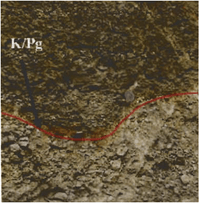
"The GSSP section near El Kef contains one main feature that allows for a direct correlation of this marine section with continental sections: the Ir anomaly at the base of the Boundary Clay."[7]
The Global Boundary Stratotype Section and Point for the base of the Danian Stage is also the base GSSP for the Paleocene, Paleogene, "Tertiary", and Cenozoic at El Kef, Tunisia.
Calabrian
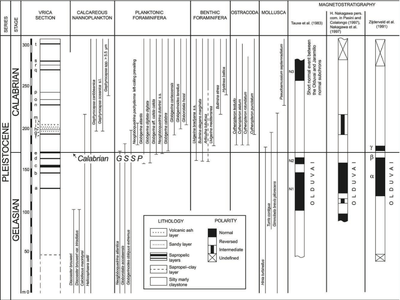
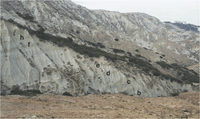
"The [Calabrian] GSSP occurs at the base of the marine claystone conformably overlying sapropelic bed ‘e’ within Segment B in the Vrica section. This lithological level represents the primary marker for the recognition of the boundary, and is assigned an astronomical age of 1.80 Ma on the basis of sapropel calibration."[8]
"The boundary falls between the highest occurrence of Discoaster brouweri (below) and the lowest common occurrence of left-coiling Neogloboquadrina pachyderma (above), and below the lowest occurrences of medium-sized Gephyrocapsa (including G. oceanica) and Globigerinoides tenellus."[8]
In the image on the right, the Vrica section includes specifically the GSSP of the Calabrian Stage fixed at the top of layer ‘e’.
Mesozoic
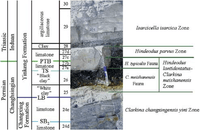
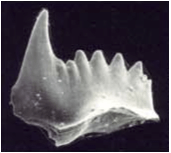
In the diagram on the right, the Permian-Triassic boundary is at the base of the Induan limestone that occurs within the Yinkeng Formation.
"The Global Stratotype Section and Point (GSSP) of the Permian-Triassic boundary [...] is defined at the base of Hindeodus parvus horizon, i.e. the base of Bed 27c of Meishan section D, Changxing County, Zhejiang Province, South China."[9]
"Hindeodus parvus is now recognized as the index fossil" occurring in the Zone above the P-T boundary.[9]
Cretaceous
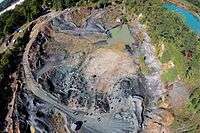
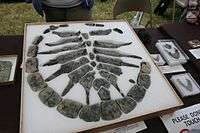
"Paleogeographically, the sub-alpine terrain of southeastern France [...] was located on the proximal part of the South-European Tethys margin. It includes the Vocontian Basin, which experienced relatively high rates of subsidence during Jurassic and Early Cretaceous times, bordered by carbonate platforms limited by a net of extensional or strike–slip faults (Graciansky et al., 1999)."[6]
This phraseology connects "Early Cretaceous" with "times".
The aerial image on the right shows the quarry pit in Mantua Township in central New Jersey has been owned by the Inversand Company for nearly a century.[10]
"When an asteroid hit the Earth around 66 million years ago, it wiped out almost 75 percent of the plants and animals on the planet. All dinosaurs, except those that would eventually give rise to modern birds, were killed following the impact. Yet despite such a vast die-off, no bone bed containing a concentration of fossils as a result of this event has been found."[10]
“We don’t know yet [if it dates from the mass extinction], but we are testing this hypothesis by examining the fossils, the sediments and the chemistry.”[11]
"At the end of the Cretaceous, when the dinosaurs met their maker, the region was a shallow tropical sea full of fish, sea turtles, crocodiles, and even mosasaurs. But at some point around 66 million years ago, whether it was due to the asteroid impact or some other cause, many of the inhabitants of the sea died and were preserved in a large bone bed."[10]
On the left is a specimen of Catapleura repanda from the Rowan quarry found in the Cretaceous marl.
Paleozoic
The paleozoic spans the time from 542.0 ± 1.0 x 106 b2k to 251.0 ± 0.7 x 106 b2k and is a geologic era.
Guzhangian
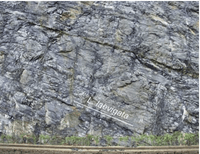

"The Global boundary Stratotype Section and Point (GSSP) for the base of the Guzhangian Stage (Cambrian Series 3) is defined at the base of a limestone (calcisiltite) layer 121.3 m above the base of the Huaqiao Formation in the Louyixi section along the Youshui River (Fengtan Reservoir), about 4 km northwest of Luoyixi (4 km southeast of Wangcun), in northwestern Hunan, China."[12]
"The GSSP level contains the lowest occurrence of the cosmopolitan agnostoid trilobite Lejopyge laevigata [in the image on the left] (base of the L. laevigata Zone)."[12]
Precambrian
Def.
- "the time and geology dated before the Phanerozoic"[13] or
- the "eon (or supereon) and rock formations dated before 541.0±1.0 million years ago, coinciding with the first appearance of the fossils of hard-shelled animals"[13]
is called the precambrian.
Usage notes[13]
- The International Commission on Stratigraphy, which attempts to standardize the vocabulary of the field, is revising the boundaries between time periods based on physical-science methods rather than the kinds of fossils present.
- The boundary between the Precambrian and the Phanerozoic has been changed from time to time and will be subject to change.
Proterozoic
Def. the "eon from 2,500 Ma to 541.0±1.0 Ma, the beginning of the Phanerozoic, marked by the build up of oxygen in the atmosphere and the emergence of primitive multicellular life"[14] is called the Proterozoic.
Adelaidean
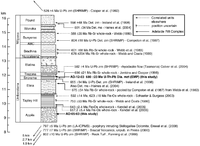
The Adelaidean appears to encompass the Delamerian Granites and the Adelaide Rift Complex.
"The deposits include the type sections for the often globally correlated Sturtian and Marinoan glacial sequences (e.g., Preiss, 2000) and the Global Stratotype Section and Point (GSSP) for the newly defined Ediacaran Period (Knoll et al., 2004)."[15]
The later Adelaidean includes the Burra and Caliana Groups.[15]
Neoproterozoic
Def. "a geologic era within the Proterozoic eon; comprises the Tonian, Cryogenian and Ediacaran periods from about 1000 to 544 million years ago, when algae and sponges flourished"[16] is called the Neoproterozoic.
Ediacaran
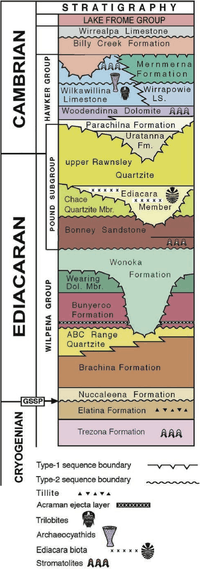
"In the central Flinders Ranges the 4.5 km thick Umberatana Group encompasses the two main phases of glacial deposition (see Thomas et al., 2012). The carbonaceous, calcareous and pyritic Tindelpina Shale Member, of the interglacial Tapley Hill Formation, caps the Fe-rich diamictite and tillite formations of the Sturt glaciation. The upper Cryogenian glacials of the Elatina Formation are truncated by the Nuccaleena Formation at the base of the Wilpena Group and the Ediacaran System."[17]
"In 2004, the Global Stratotype Section and Point (GSSP) for the terminal Proterozoic was placed near the base of the Nuccaleena Formation in Enorama Creek in the central Flinders Ranges [in the image on the right], thus establishing the Ediacaran System and Period (Knoll et al., 2006). As the Nuccaleena Formation has not been accurately dated, a date of c. 635 Ma from near-correlative levels in Namibia and China is presumed for the base of the Ediacaran (Hoffmann et al., 2004; Condon et al., 2005; Zhang et al., 2005)."[17]
Cryogenian ice age
Def. "a geologic period within the Neoproterozoic era from about 850 to 600 million years ago"[18] is called the Cryogenian.
Apparently two major glacial periods occurred during the Cryogenian: the Marinoan and the Sturtian.
Mesoproterozoic
Def. "a geologic era within the Proterozoic eon; comprises the Calymmian, Ectasian and Stennian periods from about 1600 to 900 million years ago, when the Rodinia supercontinent was formed"[19] is called the Mesoproterozoic.
Paleoproterozoic
Def. the "era from 2,500 Ma to 1,600 Ma, marked by a dramatic increase in atmospheric oxygen"[20] is called the Paleoproterozoic.
Azoic
Def.
- destitute "of any vestige of organic life, or at least of animal life",[21]
- anterior "to the existence of animal life",[21] or
- formed "when there was no animal life on the globe"[21]
is called the azoic.
Hypozoic
Def. "older than the lowest rocks which contain organic remains"[22] is called the hypozoic.
Archean
Archaean is an alternate spelling of Archean.
Def.
- "the geologic eon from about 3,800 to 2,500 million years ago; comprises the Eoarchean, Paleoarchean, Mesoarchean and Neoarchean eras; marked by an atmosphere with little oxygen, the formation of the first continents and oceans and the emergence of simple life"[23] or
- the "eon from 2,500 Ma to 4,000 Ma"[23]
is called the Archaean, or Archean.
Neoarchean
Def.
- "a geologic era within the Archaean eon from about 2800 to 2500 million years ago"[24] or
- the "era from 2,800 Ma to 2,500 Ma"[24]
is called the Neoarchean.
Mesoarchean
Def.
- "a geologic era within the Archaean eon from about 3200 to 2800 million years ago; stromatolites have existed from this time"[25] or
- the "era from 3,200 Ma to 2,800 Ma"[25]
is called the Mesoarchean.
Paleoarchean
Def.
- "a geologic era within the Archaean eon from about 3600 to 3200 million years ago; the first aerobic bacteria appeared at this time"[26] or
- the "era from 3,600 Ma to 3,200 Ma"[26]
is called the paleoarchean.
Eoarchean
Def.
- "a geologic era within the Archaean eon from about 4600 to 3600 million years ago; the first single-celled life began at this time"[27] or
- the "era from 4,000 Ma to 3,600 Ma"[27]
is called the Eoarchean.
Hadean
Def.
- "the geologic eon from about 4,600 to 3,800 million years ago; marked by the formation of the solar system, a stable Earth-Moon orbit and the first rocks"[28] or
- the "eon before 4,000 Ma"[28]
is called the Hadean.
Locations on Earth
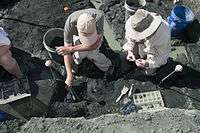
At the Inversand quarry, "Located in South Jersey, the cradle of dinosaur paleontology, the quarry in Mantua Township, N.J., contains thousands of fossils dating back 65 million years."[29]
Research
Hypothesis:
- Each time frame or span of time in geochronology has at least one dating technique.
- Late Jurassic and Upper Jurassic are different time frames.
Control groups

The findings demonstrate a statistically systematic change from the status quo or the control group.
“In the design of experiments, treatments [or special properties or characteristics] are applied to [or observed in] experimental units in the treatment group(s).[30] In comparative experiments, members of the complementary group, the control group, receive either no treatment or a standard treatment.[31]"[32]
Proof of concept
Def. a “short and/or incomplete realization of a certain method or idea to demonstrate its feasibility"[33] is called a proof of concept.
Def. evidence that demonstrates that a concept is possible is called proof of concept.
The proof-of-concept structure consists of
- background,
- procedures,
- findings, and
- interpretation.[34]
See also
References
- ↑ stratigraphy.org. "International Commission on Stratigraphy 2008". Retrieved 9 March 2009.
- ↑ Mike Walker, Sigfus Johnsen, Sune Olander Rasmussen, Trevor Popp, Jørgen-Peder Steffensen, Phil Gibbard, Wim Hoek, John Lowe, John Andrews, Svante Björck, Les C. Cwynar, Konrad Hughen, Peter Kershaw, Bernd Kromer, Thomas Litt, David J. Lowe, Takeshi Nakagawa, Rewi Newnham and Jakob Schwander (2009). "Formal definition and dating of the GSSP (Global Stratotype Section and Point) for the base of the Holocene using the Greenland NGRIP ice core, and selected auxiliary records". Journal of Quaternary Science 24 (1): 3-17. doi:10.1002/jqs.1227. http://www.stratigraphy.org/GSSP/Holocene.pdf. Retrieved 2015-01-18.
- ↑ Names from local versions of the geologic timescale can often be found in the local language. The English name is usually found by replacing the suffix in the local language for -an or -ian. Examples for "local" suffices are -en (French), -ano (Spanish), -ium (German), -aidd (Welsh) or -aan (Flemish Dutch). The English name "Norian", for example, becomes Noriano in Spanish, Norium in German, Noraidd in Welsh or Norien in French.
- 1 2 Time is given in Megaannum (million years BP, unless other units are given in the table. BP stands for "years before present". For ICS-units the absolute ages are taken from Gradstein et al. (2004).
- 1 2 Hoffmann et al. 2004
- 1 2 3 4 Slah Boulila, Bruno Galbrun, Linda A. Hinnov, Pierre-Yves Collin (January 2008). "High-resolution cyclostratigraphic analysis from magnetic susceptibility in a Lower Kimmeridgian (Upper Jurassic) marl–limestone succession (La Méouge, Vocontian Basin, France)". Sedimentary Geology 203 (1-2): 54-63. http://www.sciencedirect.com/science/article/pii/S0037073807002928. Retrieved 2015-01-27.
- ↑ Eustoquio Molina, Laia Alegret, Ignacio Arenillas, José A. Arz, Njoud Gallala, Jan Hardenbol, Katharina von Salis, Etienne Steurbaut, Noël Vandenberghe, and Dalila Zaghbib-Turki (December 2006). "The Global Boundary Stratotype Section and Point for the base of the Danian Stage (Paleocene, Paleogene, "Tertiary", Cenozoic) at El Kef, Tunisia - Original definition and revision". Episodes 29 (4): 263-73. http://www.stratigraphy.org/GSSP/Danian.pdf. Retrieved 2015-01-19.
- 1 2 Maria Bianca Cita, Philip L. Gibbard, Martin J. Head, and the ICS Subcommission on Quaternary Stratigraphy (September 2012). "Formal ratification of the GSSP for the base of the Calabrian Stage (second stage of the Pleistocene Series, Quaternary System)". Episodes 35 (3): 388-97. http://www.stratigraphy.org/GSSP/Calabrian2.pdf. Retrieved 2015-01-18.
- 1 2 Yin Hongfu, Zhang Kexin, Tong Jinnan, Yang Zunyi and Wu Shunbao (June 2001). [http://www.stratigraphy.org/GSSP/Induan.pdf "The Global Stratotype Section and Point (GSSP) of the Permian-Triassic Boundary"]. Episodes 24 (2): 102-14. http://www.stratigraphy.org/GSSP/Induan.pdf. Retrieved 2015-01-20.
- 1 2 3 Josh L Davis (12 January 2016). "Paleontologists Believe They Have Discovered The First Fossil Bed From The Dinosaur Extinction Event Itself". iflscience. Retrieved 2016-01-16.
- ↑ Kenneth Lacovara (12 January 2016). "Paleontologists Believe They Have Discovered The First Fossil Bed From The Dinosaur Extinction Event Itself". iflscience. Retrieved 2016-01-16.
- 1 2 Shanchi Peng, Loren E. Babcock, Jingxun Zuo, Huanling Lin, Xuejian Zhu, Xianfeng Yang, Richard A. Robison, Yuping Qi, Gabriella Bagnoli, and Yong’an Chen (March 2009). "The Global Boundary Stratotype Section and Point (GSSP) of the Guzhangian Stage (Cambrian) in the Wuling Mountains, Northwestern Hunan, China". Episodes 32 (1): 41-55. http://www.stratigraphy.org/GSSP/Guzhangian.pdf. Retrieved 2015-01-21.
- 1 2 3 "Precambrian, In: Wiktionary". San Francisco, California: Wikimedia Foundation, Inc. 4 November 2014. Retrieved 2015-02-12.
- ↑ "Proterozoic, In: Wiktionary". San Francisco, California: Wikimedia Foundation, Inc. 1 January 2015. Retrieved 2015-02-13.
- 1 2 K.H. Mahan, B.P. Wernicke, and M.J. Jercinovic (15 January 2010). "Th–U–total Pb geochronology of authigenic monazite in the Adelaide rift complex, South Australia, and implications for the age of the type Sturtian and Marinoan glacial deposits". Earth and Planetary Science Letters 289 (1-2): 76-86. ftp://eclogite.geo.umass.edu/pub/probe/other/Mahan_etal_2010_Adelaide_Mzt.pdf. Retrieved 2015-01-17.
- ↑ "Neoproterozoic, In: Wiktionary". San Francisco, California: Wikimedia Foundation, Inc. 7 October 2013. Retrieved 2015-02-13.
- 1 2 James G. Gehling and Mary L. Droser (March 2012). "Ediacaran stratigraphy and the biota of the Adelaide Geosyncline, South Australia". Episodes 35 (1): 236-46. http://www.episodes.co.in/contents/2012/march/p236-246.pdf. Retrieved 2015-01-19.
- ↑ "Cryogenian, In: Wiktionary". San Francisco, California: Wikimedia Foundation, Inc. 5 November 2014. Retrieved 2015-02-13.
- ↑ "Mesoproterozoic, In: Wiktionary". San Francisco, California: Wikimedia Foundation, Inc. 7 October 2013. Retrieved 2015-02-13.
- ↑ "Paleoproterozoic, In: Wiktionary". San Francisco, California: Wikimedia Foundation, Inc. 4 November 2014. Retrieved 2015-02-13.
- 1 2 3 "azoic, In: Wiktionary". San Francisco, California: Wikimedia Foundation, Inc. 15 December 2014. Retrieved 2015-02-12.
- ↑ "hypozoic, In: Wiktionary". San Francisco, California: Wikimedia Foundation, Inc. 23 May 2014. Retrieved 2015-02-12.
- 1 2 "Archaean, In: Wiktionary". San Francisco, California: Wikimedia Foundation, Inc. 1 February 2015. Retrieved 2015-02-12.
- 1 2 "Neoarchean, In: Wiktionary". San Francisco, California: Wikimedia Foundation, Inc. 8 November 2014. Retrieved 2015-02-12.
- 1 2 "Mesoarchean, In: Wiktionary". San Francisco, California: Wikimedia Foundation, Inc. 4 November 2014. Retrieved 2015-02-12.
- 1 2 "Paleoarchean, In: Wiktionary". San Francisco, California: Wikimedia Foundation, Inc. 4 November 2014. Retrieved 2015-02-12.
- 1 2 "Eoarchean, In: Wiktionary". San Francisco, California: Wikimedia Foundation, Inc. 4 November 2014. Retrieved 2015-02-12.
- 1 2 "Hadean, In: Wiktionary". San Francisco, California: Wikimedia Foundation, Inc. 4 November 2014. Retrieved 2015-02-13.
- ↑ Michelle Bruner (January 2016). "The Rowan University Fossil Quarry". Mantua Township, N.J.: Rowan University. Retrieved 2016-01-18.
- ↑ Klaus Hinkelmann, Oscar Kempthorne (2008). Design and Analysis of Experiments, Volume I: Introduction to Experimental Design (2nd ed.). Wiley. ISBN 978-0-471-72756-9. http://books.google.com/?id=T3wWj2kVYZgC&printsec=frontcover.
- ↑ R. A. Bailey (2008). Design of comparative experiments. Cambridge University Press. ISBN 978-0-521-68357-9. http://www.cambridge.org/uk/catalogue/catalogue.asp?isbn=9780521683579.
- ↑ "Treatment and control groups, In: Wikipedia". San Francisco, California: Wikimedia Foundation, Inc. May 18, 2012. Retrieved 2012-05-31.
- ↑ "proof of concept, In: Wiktionary". San Francisco, California: Wikimedia Foundation, Inc. November 10, 2012. Retrieved 2013-01-13.
- ↑ Ginger Lehrman and Ian B Hogue, Sarah Palmer, Cheryl Jennings, Celsa A Spina, Ann Wiegand, Alan L Landay, Robert W Coombs, Douglas D Richman, John W Mellors, John M Coffin, Ronald J Bosch, David M Margolis (August 13, 2005). "Depletion of latent HIV-1 infection in vivo: a proof-of-concept study". Lancet 366 (9485): 549-55. doi:10.1016/S0140-6736(05)67098-5. http://www.ncbi.nlm.nih.gov/pmc/articles/PMC1894952/. Retrieved 2012-05-09.
External links
| |||||||||||||||||||||||||||||||||||
![]() This is a research project at http://en.wikiversity.org
This is a research project at http://en.wikiversity.org
| |
Development status: this resource is experimental in nature. |
| |
Resource type: this resource is an article. |
| |
Resource type: this resource contains a lecture or lecture notes. |
| |
Subject classification: this is a Geology resource. |